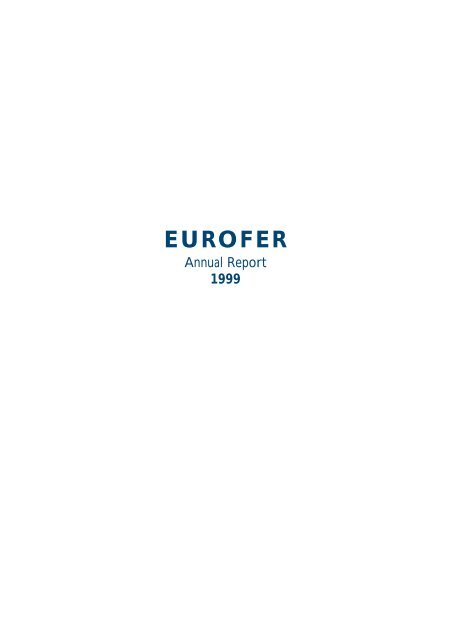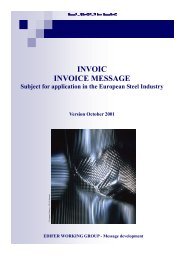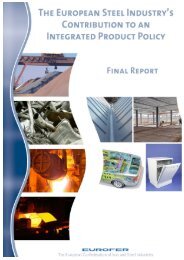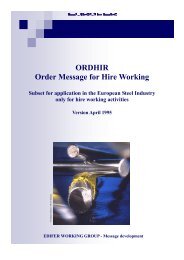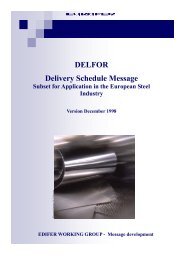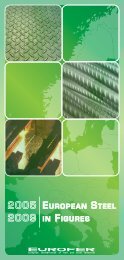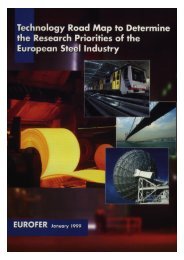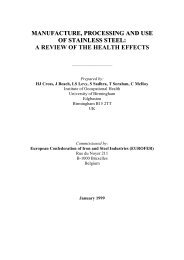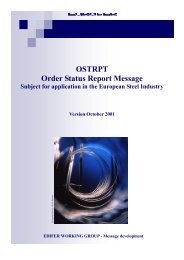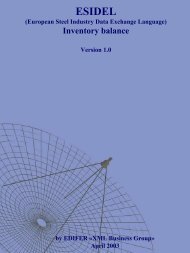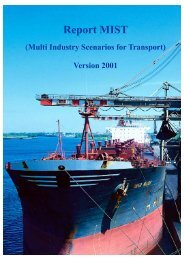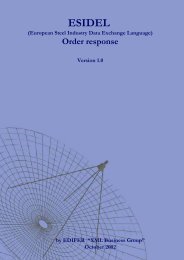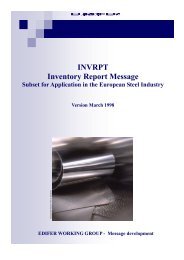Steel Market - Eurofer
Steel Market - Eurofer
Steel Market - Eurofer
Create successful ePaper yourself
Turn your PDF publications into a flip-book with our unique Google optimized e-Paper software.
EUROFER<br />
Annual Report<br />
1999
The European Confederation of Iron and <strong>Steel</strong> Industries (EUROFER) was<br />
founded in 1976. Members and Associate Members are steel companies and national steel<br />
federations throughout the European Union and the Central and Eastern European Countries.<br />
In 1999, 149 million tonnes of crude steel were produced by the European Union<br />
Member Companies of EUROFER.This represents about 96% of the total production in the<br />
European Union.The Associate Members with 25 million tonnes of crude steel represent 92%<br />
of the production of the Central and Eastern European Countries.<br />
The objectives of EUROFER are the co-operation amongst the national federations<br />
and companies in all matters, which contribute to the development of the European steel<br />
industry and the representation of the common interests of its members vis-à-vis third parties,<br />
notably the European institutions and other international organisations.
Contents<br />
Introduction 3<br />
General Economic Development 5<br />
<strong>Steel</strong> <strong>Market</strong> 7<br />
Deliveries of Carbon <strong>Steel</strong>s 10<br />
Deliveries of Special <strong>Steel</strong>s 12<br />
Crude <strong>Steel</strong> Production 14<br />
Trade Policy 17<br />
Raw Materials 21<br />
Investments 25<br />
Technology and Environment 29<br />
Research 29<br />
Standards 30<br />
Environment 30<br />
Human Resources 39<br />
ECSC Budget 41<br />
Statistics 43<br />
EDIFER 45<br />
<strong>Steel</strong> shaping the Future 47<br />
Annexes 49
Introduction<br />
At the beginning of 1999 the steel industry in the EU was still suffering from the poor market<br />
conditions provoked by the huge trade distortions in the previous year which resulted from the regional<br />
crises in Asia and Russia.A massive import surge accompanied by clear cases of dumping led to a collapse<br />
of prices which were at their lowest point in the first months of 1999. However, in the course of the year<br />
demand recovered and prices gradually improved.This trend is continuing and accelerating in the year<br />
2000 founded on sound economic fundamentals in the European economy and the improved<br />
international context. Crude steel production in the EU this year will therefore show a considerable<br />
increase over that of 1999 and the financial results of companies will be much improved.<br />
The process of consolidation of the industry continued in 1999. Further mergers, co-operation<br />
and strategic partnerships on a global scale are to be expected.The challenge of fast-changing market<br />
conditions, competitive pressure and the on-going concentration within major consuming sectors obliges<br />
the industry to seek all possible synergies and to achieve the economies of scale required to operate in a<br />
global market.<br />
Moreover, the growing internationalisation of the steel market has highlighted the importance<br />
of assuring the conditions of fair trade.The recent crisis demonstrated that the application of the rules<br />
governing fair trade are at present neither equitable in some instances nor efficient in others. <strong>Eurofer</strong><br />
therefore is advocating, in the context of the new WTO Round a greater harmonisation of the<br />
implementation of the existing Anti-dumping Agreement.<br />
The steel industry is committed to sustainable development and a continuous improvement<br />
of its environmental performance, and it has an excellent track record in this respect. <strong>Steel</strong> is the world's<br />
most recycled material.The use of ferrous scrap as a raw material helps in preserving natural resources<br />
and in keeping the environment clean. Another example is the steady reduction of energy requirements<br />
and carbon dioxide emissions achieved over many decades.This development has been driven so far that<br />
the limits set by the laws of physics are being approached.<br />
The Kyoto Protocol for reduction of greenhouse gas emissions provides a challenge for the steel<br />
industry. Some further reduction of carbon dioxide emissions can be achieved by future investments in<br />
new plants and processes, but the potential is limited as mentioned above.A carbon energy tax is unlikely<br />
to result in reduction of carbon dioxide emissions. Its effect on the industry would be to push up input<br />
costs, not reduce unit energy consumption. Such a tax would also reduce the funds available for<br />
investment in research and development and in other projects necessary for improved energy efficiency.<br />
The steel industry instead supports voluntary or negotiated agreements at national level for further<br />
improvement of energy efficiency.<br />
Prof. Dr. Ekkehard Schulz<br />
President<br />
Dietrich von Hülsen<br />
Director General<br />
3<br />
EUROFER 1999
General Economic Development<br />
For the EU, 1999 was a comparatively modest year in terms of economic growth.<br />
The economic difficulties internationally translated in the first half of the year into a fall in<br />
trade volumes and a loss of business confidence. As inventory levels were reduced and<br />
investment growth weakened, so industrial production fell. However, domestic demand<br />
provided a solid basis for economic expansion, even in the first semester, reflecting the<br />
underlying strength of the European economy.<br />
The elements which had acted as a drag on growth largely dissipated in the course<br />
of the second half of the year and recovery took hold rapidly, with the highest contribution<br />
to growth coming from the acceleration in exports.<br />
Private consumption, although down slightly on the previous year, remained quite<br />
strong throughout 1999. Favourable domestic demand conditions, particularly in the second<br />
half of the year, and rising capital profitability stimulated investment growth which, especially<br />
for machinery and equipment, accelerated strongly towards the end of the year.<br />
Development of Certain Elements of the EU Economy<br />
(yearly variations in %)<br />
1998 1999 2000<br />
(forecast)<br />
GDP 2.7 2.3 3.4<br />
Private consumption 3.0 2.8 2.8<br />
Investments 5.7 5.1 5.6<br />
of which Investments in equipment 9.7 6.7 7.5<br />
Exports 5.9 4.0 8.2<br />
Imports 8.9 6.1 7.7<br />
Employment 1.3 1.3 1.3<br />
Unemployment rate 9.9 9.2 8.5<br />
Inflation 1.3 1.2 1.8<br />
Source: Official data and estimations of the European Commission<br />
Fiscal policy was mildly<br />
supportive of growth, as were the record<br />
low interest rates and the continuing<br />
comparative weakness of the euro<br />
vis-à-vis the US dollar.<br />
On the basis of these factors,<br />
GDP growth was considerably higher<br />
than had been forecast when the year<br />
began.<br />
5<br />
EUROFER 1999
<strong>Steel</strong> <strong>Market</strong><br />
Consumption<br />
Despite declining for the first three quarters of 1999, real consumption for the<br />
year as a whole was only just below the generally satisfactory levels of 1998.The acceleration<br />
of real consumption in the last months of 1999 went some way to improving the results<br />
for the year as a whole. However, it<br />
Share of Consumption by <strong>Steel</strong>-using Sector<br />
did not completely offset the fall in<br />
demand in the first semester caused by<br />
STRUCT. STEELWORK<br />
the downturn in export orders and<br />
CONSTRUCTION<br />
14%<br />
10%<br />
MECHANICAL ENG.<br />
9%<br />
industrial output in the European<br />
economy as a whole.<br />
OTHERS<br />
7%<br />
AUTOMOTIVE<br />
13%<br />
The activity of steel-using sectors<br />
DOMESTIC APPLIANCE<br />
METALWARE<br />
3%<br />
SHIPYARDS<br />
in 1998 was considerably higher than<br />
15%<br />
TUBES<br />
1%<br />
the rest of the economy. The relative<br />
FIRST PROCESSING<br />
13%<br />
fall in activity in 1999 has to be seen in<br />
15%<br />
that context. Equally, it was those sectors<br />
most exposed to changed conditions on<br />
international markets and investments – machinery and equipment, first processing activities<br />
– that suffered the most from the effects of the crisis in emerging markets. However, they<br />
were also the most responsive to the changing trading conditions and growing confidence of<br />
the second part of the year.<br />
Several sectors experienced difficulties in the course of the year linked to<br />
circumstances particular to their industries. For example, the large diameter tubes sector<br />
saw a sharp contraction of activity as projects in the energy sector dried up in response to<br />
the drop in oil prices, and shipbuilding in Europe showed a steep decline in activity: both of<br />
which had negative effects on the market for quarto-plate.<br />
Other sectors, such as the automotive sector, showed a surprising resilience and 1999<br />
was notable for the sharp recovery in the construction sector after several years of poor levels<br />
of activity.<br />
7<br />
EUROFER 1999
8<br />
1999<br />
EUROFER<br />
1995<br />
1996<br />
1997<br />
1998<br />
1999<br />
Real and Apparent <strong>Steel</strong> Consumption:<br />
Yearly Variation (in %)<br />
20<br />
10<br />
0<br />
-10<br />
Imports<br />
Real<br />
Consumption<br />
Apparent<br />
Consumption<br />
Apparent consumption fell back<br />
sharply in the first 6-months of 1999 but<br />
nevertheless remained at comparatively<br />
high levels in relation to the development<br />
of real demand. Deliveries of domestic<br />
producers did fall substantially, but stocks<br />
proved difficult to reduce due, in part, to<br />
the continued presence of large quantities<br />
of imports on European markets.<br />
The record import levels of 1998 went beyond the absorption capability of the EU<br />
market and led to its destabilisation. Import pressure remained extremely high in 1999.While<br />
total tonnages coming in did reduce from 16<br />
million tonnes of finished ECSC products in 1998<br />
to 14 million tonnes in 1999, imports still<br />
20<br />
remained 30% higher than in 1997.<br />
ECSC Products Excluding Semis:<br />
Imports (million tonnes)<br />
A striking characteristic of import<br />
development in 1999 was the beginning of the<br />
withdrawal of the non-traditional suppliers, who<br />
10<br />
had appeared on EU markets as a result of the<br />
1995<br />
1996<br />
Asian crisis and who imported mainly flat products.<br />
1997<br />
5<br />
Imports from Asia fell by 42% in 1999. This,<br />
1998<br />
1999<br />
however, coincided with an improvement in the<br />
construction sector and in the market for light long<br />
0<br />
products in Europe, which led to a rapid expansion<br />
Source: Comext - Eurostat<br />
of long products imports. In addition, generally improving market conditions in the EU in the<br />
second half of last year led to a return to the market of those producers who had withdrawn<br />
when faced with deteriorating prices and overstocking at the end of 1998 and beginning<br />
of 1999.<br />
1999, therefore, was characterised by a declining trend in flat products imports (which<br />
however began to change in the course of the second semester, particular for hot rolled coil,<br />
as market conditions improved), and by a rising trend for long products which partly offset<br />
the falls experienced in flat. Imports of flat products fell to 9 million tonnes, down by<br />
2.5 million tonnes, or 24%. Imports of long products rose by 1 million tonnes or 27%,<br />
to 5 million tonnes.<br />
15
Exports<br />
The acceleration of recovery in Asia in the course of the second half of 1999 led to<br />
an improvement in international demand. Exports to Asia resumed, growing by 23%.<br />
However, total exports of steel products<br />
ECSC Products Excluding Semis:<br />
Exports (million tonnes)<br />
from the EU fell again, but this fall was<br />
25<br />
less than in previous years and reflected<br />
the particularly difficult conditions on<br />
20<br />
export markets at the beginning of the<br />
year and the strong domestic market at<br />
15<br />
the end of 1999. Exports of finished<br />
10<br />
products fell by 865 Kt, or 5%, to 16.1<br />
million tonnes.<br />
1995<br />
1996<br />
1997<br />
1998<br />
1999<br />
Source: Comext - Eurostat<br />
5<br />
0<br />
Trade Balance<br />
Opportunities on export markets<br />
grew substantially in the course of the<br />
second semester of 1999, and this is<br />
expected to continue into this year.<br />
For the first time ever, the EU lost its trade surplus in ECSC steel products in 1998.<br />
Similarly, in 1999 if all ECSC products are taken into account, including semis, then there is<br />
a trade deficit of just over one million tonnes. In terms of finished products alone, a surplus<br />
of 1.6 million tonnes will have been maintained, which is only a slight improvement on<br />
the previous year and compares with previous years when typically the surplus was around<br />
10 million tonnes.<br />
1995<br />
1996<br />
1997<br />
1998<br />
1999<br />
15<br />
10<br />
Source: Comext - Eurostat<br />
ECSC Products Excluding Semis:<br />
Trade Balance (million tonnes)<br />
5<br />
0<br />
9<br />
EUROFER 1999
10<br />
1999<br />
EUROFER<br />
DELIVERIES OF CARBON STEELS<br />
Total deliveries within the European<br />
Union and to third countries of rolled finished<br />
products in carbon steel (defined as non-alloy and<br />
alloy steels other than stainless) increased by 1.8% 1 .<br />
In spite of falling prices in the first half of the<br />
year, deliveries within the European Union<br />
increased by 2.9%.<br />
The decrease of the exports to third<br />
countries (-5.6%) showed a smaller reduction<br />
than in the two preceding years.<br />
Flat Products<br />
After two years of strong growth rates (15%<br />
in 1997 and 7% in 1998) the apparent consumption<br />
of flat products in the European Union showed a<br />
small reduction (-0.6%) in 1999.The recovered<br />
market share of the European mills, due to lowered<br />
imports from third countries combined with a<br />
normalisation of stocks, led however to deliveries<br />
within the EU increasing by 3%.<br />
Prices in 1999 fell to a historical low level.<br />
As from the second quarter, the downward trend<br />
was reversed and price recovery started with the<br />
third quarter.<br />
Carbon <strong>Steel</strong>s:<br />
Flat Products Deliveries (million tonnes)<br />
Compared to 1998, deliveries of hot rolled flat products (+ 7%) and coated sheet (+ 6%)<br />
showed a positive development. On the other hand a reduction of deliveries was observed for<br />
black plate/tin plate (-6%) and electrical sheet (-2%).The low activity of tubemakers led to a fall<br />
in quarto-plate/wide flats deliveries by 6%.<br />
1 Figures now include the deliveries of two Scandinavian producers and can therefore not be<br />
compared with those of the annual reports of the preceding years.<br />
1997<br />
1998<br />
1999<br />
1997<br />
1998<br />
1999<br />
Carbon <strong>Steel</strong>s:<br />
Total Deliveries (million tonnes)<br />
Total of which EU of which<br />
THIRD COUNTRIES<br />
Total of which EU of which<br />
THIRD COUNTRIES
Carbon <strong>Steel</strong>s:<br />
Delivery Structure of Cold Rolled Products (in%)<br />
Total Coated<br />
C.R. Sheets<br />
Carbon <strong>Steel</strong>s: Development of Coated Products<br />
Deliveries within the EU (index)<br />
Electroz<br />
Hot Dipped<br />
Organic<br />
Long Products<br />
Deliveries of cold rolled sheets have<br />
been decreasing since 1998, but the<br />
reduction in 1999 (-1%) was less than the<br />
previous year.<br />
The ongoing substitution of<br />
uncoated cold rolled sheet by coated<br />
material continued in 1999. During the<br />
last six years, the structure of total cold<br />
rolled products deliveries changed by 10%<br />
in favour of coated sheets.<br />
Also during the last six years,<br />
deliveries of hot dipped galvanized<br />
sheets have nearly doubled within the<br />
European Union. This is mainly due to<br />
increased consumption of this product in<br />
the automotive sector. Deliveries of<br />
electrozinc were unchanged for the first<br />
time during the last three years.<br />
Exports to third countries dropped<br />
by 2.2%, remaining nearly at the same<br />
level as 1998.<br />
The market supply of long products within the EU increased by 5%.As in the past,<br />
this was due to the extended market share of third country imports. Deliveries of the<br />
European producers increased by 2.9%.<br />
At the beginning of 1999, prices were at their lowest levels. Although the recovery<br />
started during the second quarter, by the end of the year they had still not returned to the<br />
levels of the first half of 1998.<br />
11<br />
EUROFER 1999
12<br />
1999<br />
EUROFER<br />
1997<br />
1998<br />
1999<br />
1997<br />
1998<br />
1999<br />
Carbon <strong>Steel</strong>s:<br />
Long Products Deliveries (million tonnes)<br />
Total of which EU of which<br />
THIRD COUNTRIES<br />
DELIVERIES OF SPECIAL STEELS<br />
Deliveries within the EU were strong for<br />
railway material (+11%) and heavy sections<br />
(+10%). Wire rod increased by 4% and<br />
reinforcing bars by 1%. Sheet piling deliveries<br />
fell by 2% and merchant bars by 1%.<br />
Exports to third countries fell by 13.5%,<br />
mainly because prices in most world markets<br />
remained unattractive up to mid-1999. The<br />
improved situation in South East Asia and the<br />
strong position of the US dollar significantly<br />
contributed to their recovery by the end of<br />
the year.<br />
During the major part of 1999, the negative trend which had been spotted in the<br />
second half of 1998 under the influence of the Asian financial crisis continued to affect<br />
apparent consumption of special steels in general.<br />
In the first half of 1999, total special steels sales decreased by 7.3% compared to the<br />
satisfactory level of the same period in 1998. As a consequence, activity and price levels in<br />
Europe came under considerable pressure. As from the third quarter of 1999, with signs of<br />
economic recovery and sustained growth in real consumption, demand and order bookings<br />
by the EU producers started to pick up again and total deliveries in the fourth quarter of<br />
1999 improved by 6.5% compared to the fourth quarter of 1998.<br />
For the whole year, total deliveries by the EU special steels producers decreased by<br />
2.9%. For the year 2000, the outlook is clearly positive with a high activity level in most of<br />
the market segments. For the main categories of<br />
special steels (stainless steels, alloy engineering,<br />
tool and high speed steels), the situation was the<br />
following :<br />
Stainless <strong>Steel</strong>s:<br />
Development of Deliveries (million tonnes)<br />
Total of which EU of which<br />
THIRD COUNTRIES<br />
Stainless <strong>Steel</strong> Deliveries: +4.7%<br />
of which to EU markets: +3.2%<br />
of which to export markets: +10.7%
Source: Metal Bulletin<br />
For stainless steels, 1999 was also characterised by sluggish demand in the first half-year<br />
(- 0.2%) followed by a strong expansion of supplies to the EU and export markets in the<br />
second half of the year (+ 10.3%).This was driven by robust growth of real consumption in<br />
Europe, the need to rebuild inventories and the export opportunities propelled by the strong<br />
US dollar and high demand in Asia and America. This trend is continuing in 2000 where<br />
European producers are recording long delivery lead times and full capacity use.A significant<br />
price recovery has been noticed, which mirrors the dramatic price increase of raw materials,<br />
especially of nickel.<br />
Nickel:<br />
Development of Quotations (US $/tonne)<br />
Regarding alloy engineering, tool and<br />
high speed steels, the slowdown in demand<br />
which had started in the second half of 1998<br />
continued significantly during the major part<br />
of 1999; total sales during the January<br />
– September 1999 period fell by 13% compared<br />
to the same 1998 period.This was mainly due to<br />
the continuation of the destocking process and<br />
a slower activity in user sectors linked to investment goods, which was not compensated by<br />
the sustained activity level in the automotive industry.<br />
As from the fourth quarter of 1999, with<br />
business confidence improving world-wide, a clear<br />
upturn in apparent consumption took place on<br />
the EU market and total sales increased by 4.9%<br />
compared to the fourth quarter of 1998. The<br />
recovery in price and volume terms has, so far,<br />
been confirmed for year 2000 business.<br />
Alloy Engineering, Tool and High Speed <strong>Steel</strong>s: –9.3%<br />
of which to EU markets: –7.7%<br />
of which to export markets: –28.1%<br />
Alloy Engineering, Tool and High Speed <strong>Steel</strong>s:<br />
Development of Deliveries (million tonnes)<br />
1997<br />
1998<br />
1999<br />
Total of which EU of which<br />
THIRD COUNTRIES<br />
13<br />
EUROFER 1999
14<br />
1999<br />
EUROFER<br />
CRUDE STEEL PRODUCTION<br />
Despite the strong recovery in crude<br />
steel production levels in the last quarter of the<br />
year, production for the year as a whole in the<br />
EU fell by 3% reflecting the difficult market<br />
conditions which existed for much of the year<br />
both in the EU itself and on international<br />
markets.<br />
EU Crude <strong>Steel</strong> Balance<br />
(million tonnes)<br />
Source: Eurostat<br />
EU Crude <strong>Steel</strong> Production<br />
(million tonnes)<br />
1996 1997 1998 1999 2000 99/98 2000/99<br />
(forecast) % changes<br />
Real consumption 139.2 149.8 157.6 157.0 159.0 –0.4 1.3<br />
Stocks: merchants/users –3.7 1.0 3.0 –2.0 –1.0 -- --<br />
Apparent Consumption 135.5 150.8 160.6 155.0 158.0 –3.5 1.9<br />
Imports 12.2 14.3 21.4 19.0 19.0 –11.2 0.0<br />
Exports 27.9 23.9 20.0 19.0 20.0 –5.0 5.3<br />
Balance 15.7 9.6 –1.0 0.0 1.0 -- --<br />
Stocks: works – 4.6 –1.0 2.0 0.0 0.0 -- --<br />
Crude <strong>Steel</strong> Production 146.6 159.4 159.6 155.0 159.0 –2.9 2.6<br />
Source: Official data and estimation of the European Commission (rounded figures)<br />
1995<br />
1996<br />
1997<br />
1998<br />
1999
1999 saw the beginning of the consolidation of recovery in the steel markets in<br />
Russia and South East Asia which had collapsed as a result of the financial crisis of the<br />
previous two years. <strong>Steel</strong> production rose strongly.The notable exception to this was Japan,<br />
where production levels remained low in response to continued weakness in the domestic<br />
economy.<br />
The USA, suffering from the impact of the Asian crisis, saw a pattern of production<br />
not dissimilar to that of the EU with a reduction in the first half of the year, followed by an<br />
accelerating improvement in the second.<br />
World Crude <strong>Steel</strong> Production<br />
(million tonnes)<br />
1998 1999 % 1999/1998<br />
World 777 788 1.4<br />
Europe 207 198 –4.3<br />
of which EU 15 160 155 –3.1<br />
Former USSR 74 86 16.2<br />
Asia 298 308 3.4<br />
of which China 115 124 7.8<br />
of which Japan 94 94 --<br />
of which South Korea 40 41 2.5<br />
North and Central America 130 130 --<br />
of which USA 99 97 –2.0<br />
South America 36 35 –2.8<br />
Africa, Middle East and Oceania 32 31 –3.1<br />
Source: IISI<br />
OTHER ASIA<br />
6%<br />
AFRICA - M.EAST - OCEANIA<br />
4%<br />
SOUTH AMERICA<br />
4%<br />
SOUTH KOREA<br />
5%<br />
World Crude <strong>Steel</strong> Production<br />
Geographical Breakdown<br />
CHINA<br />
16%<br />
E.U.<br />
21%<br />
JAPAN<br />
12%<br />
U.S.A.<br />
12%<br />
OTHER EUROPE<br />
5%<br />
FORMER U.S.S.R.<br />
11%<br />
OTHER NORTH AMERICA<br />
4%<br />
15<br />
EUROFER 1999
Trade Policy<br />
The effects of the Asian crisis, which began in July 1997, and which led directly to<br />
the exceptional rise in import levels in the EU in 1998, lingered on in 1999. Indeed, the<br />
impact in terms of market conditions and, in particular, on prices, reached its deepest point<br />
in the first half of 1999, although by that time imports had receded from their peak, since<br />
the overstocking and price collapse for which they bear the responsibility rendered the<br />
market unattractive to importers. Nevertheless, the European industry continued to pay the<br />
price for the excessive level of, often dumped, imports in the previous years.<br />
This situation threw into perspective the difficulties which the industry of the EU<br />
has in having full and timely access to its own trade defence instruments and to the<br />
shortcomings of these instruments. It highlighted the need to ensure the consistent and<br />
balanced application by the EU authorities of the Community anti-dumping regulations.<br />
Anti-dumping is essentially a technical procedure - the cases filed by the European industry<br />
demonstrated the need for disengaging these procedures from the political dimension in<br />
Europe.<br />
The response of the European steel industry to the crisis in its markets in 1998 and<br />
1999 was measured. It consisted of the filing of a small number of cases targeting key products<br />
(hot rolled coil, quarto plate and wire rod) and was limited to the worst practitioners on the<br />
market.The crisis in European markets began in 1998 and reached its deepest point in 1999.<br />
Nevertheless a final decision on the first cases introduced - for hot rolled coil – did not come<br />
until 13 months after the opening of investigations, that is not until the very end of 1999.<br />
This demonstrated that:<br />
- the current regulations on anti-dumping impose comparatively cumbersome requirements on<br />
EU industry which makes the preparation of cases lengthy and difficult.Taken together with<br />
the long investigation period of the Commission this means that relief for the affected industry<br />
comes too late.<br />
- the risk of political interference in the implementation of the procedure is great. Rather than<br />
judging each case on its technical merits, too often cases are assessed by either or both the<br />
Commission and Member States using political criteria.<br />
It became clear, therefore, in the course of the year that certain actions are necessary<br />
in order to reform the anti-dumping practices of the European Union in order to make them<br />
more effective:<br />
17<br />
EUROFER 1999
18<br />
1999<br />
EUROFER<br />
- to improve objectivity and to take the politics out of anti-dumping, a possible solution could<br />
be the creation of an agency to take decisions on injury and consumer interest;<br />
- given the current lengthy procedures, there should be an early provisional determination of<br />
injury, before provisional determination of dumping.<br />
The rash of trade cases across the world in 1999 also highlighted the lack of a full<br />
and harmonised implementation of the WTO Agreement on anti-dumping by all countries.<br />
While the WTO sets the framework, the transposition in national laws and the application<br />
of the rules varies from country to country.The failure to launch the so-called Millennium<br />
Round in Seattle in December meant that this issue could not be properly addressed. Neither<br />
the Commission nor European industry is advocating that the WTO Agreement on antidumping<br />
be re-opened. The dangers of placing a wholesale revision of the anti-dumping<br />
Agreement on the negotiating table in the context of a comprehensive round are clear.<br />
However, a greater harmonisation of the implementation of the existing agreement by WTO<br />
members, preferably towards the EU anti-dumping standards as a minimum, is desirable.<br />
Only in this way would the excessive use of anti-dumping measures as a means of harassment<br />
or of closing the market be avoided, while ensuring that the more liberal aspects of the<br />
regulation in force in the EU - aspects such as the lesser duty rule and Community interest<br />
- are adopted by all.This would ensure that European industry is not placed at a disadvantage<br />
vis-à-vis its major competitors, some of whom benefit from a national legislation which,<br />
while apparently consistent with the letter of WTO rules is nevertheless used in a highly<br />
protectionist way.<br />
Blanket filing of trade cases is one example of trade laws misuse. Recourse to the<br />
WTO safeguard clause, when there is no “significant overall impairment in the position of a<br />
domestic industry”, as happened in 1999 in the US with the safeguard proceedings regarding<br />
wire rod and welded line pipe, is another illustration of abuse of trade laws. EUROFER will<br />
strongly support that the European Commission requests the judgement of a WTO panel on<br />
this issue to avoid that recourse to safeguard measures, that should only take place in<br />
exceptional circumstances, becomes an alternative to anti-dumping cases. EUROFER is also<br />
looking forward to constructive decisions from the WTO Dispute Settlement Body on the<br />
use of the US 1916 Act to restrict access to the US market. Likewise, EUROFER expects<br />
that the WTO will put an end to the US Administration’s practice that arbitrarily penalises<br />
with countervailing duties the exports of companies which have been privatised at market<br />
price, when these companies had received government subsidies, prior to privatisation.<br />
EUROFER will be working to put forward the industry position on this subject,<br />
as on others, in the light of the expected relaunch of negotiation for the new Round in<br />
2000-2001.<br />
However, EUROFER remains convinced that the 1998 import crisis has<br />
demonstrated that present trade defence instruments do not offer the means to deal
effectively and appropriately with the problems the world steel market was faced with in<br />
these circumstances. Accordingly, in 1999 EUROFER initiated a dialogue with other key<br />
actors in the world steel market, to foster approaches that would make it possible to better<br />
address the structural problems of countries in transition and to design measures providing<br />
for consultations, to help avoid dangerous trade developments and the occurrence of injury.<br />
19<br />
EUROFER 1999
Raw Materials<br />
Iron Ore<br />
There were fairly substantial falls in prices for iron ore in the course of the year. Falls<br />
were in the order of 11% for fines and of 12% in the lump premium.The premium for pellets<br />
fell by 18%.This reflects the poor outlook for iron-making in Japan and the EU for 1999 at<br />
the beginning of the year. Iron production fell by 3% in the year as a whole, to 93 million<br />
tonnes.The price falls reflect especially the more difficult situation in the first half of the year<br />
which caused uncertainty for the year as a whole. However, the steel market and, indeed, iron<br />
and steel production picked up considerably in the second semester, leading to a result for<br />
the year which was much improved on the forecasts made earlier.<br />
Seaborne traded iron ore world-wide in 1999 was 410 million tonnes compared to<br />
415 million tonnes in 1998 and 428 million tonnes in 1997.<br />
Supply sources for iron ore expanded<br />
further in 1999 with, notably, the Hammersly<br />
Yandi project coming on-stream and producing<br />
10 million tonnes compared with a projected<br />
5 million tonnes output.<br />
The Ferteco port expansion was<br />
completed. This will increase capacity by 10<br />
million tonnes a year.<br />
Coal<br />
Prices to the EU fell by 18% in the course of the year. Imported coal is continuing<br />
to assume the place of domestic sources in the EU.The supply pattern of imports remained<br />
broadly unchanged with, however, US coal continuing to lose market share as it failed to<br />
meet the competitive conditions on the market.<br />
Scrap<br />
Source: Eurostat<br />
EU Receipts of Imported Iron Ore<br />
AUSTRALIA<br />
17%<br />
SOUTH AFRICA<br />
5%<br />
MAURITANIA<br />
9%<br />
CANADA<br />
11%<br />
OTHERS<br />
9%<br />
RUSSIA<br />
1%<br />
Throughout much of 1999, the scrap market was relatively calm with prices low in<br />
relative terms and moving only within a narrow range.<br />
BRAZIL<br />
43%<br />
VENEZUELA<br />
5%<br />
21<br />
EUROFER 1999
22<br />
1999<br />
EUROFER<br />
Demand levels for scrap, however,<br />
remained quite high due to the strong<br />
improvement in activity levels in the construction<br />
sector.Together with rapidly rising output in<br />
other sectors consuming long products, this<br />
meant that EAF (electric arc furnace) production<br />
levels, while lower than the previous year,<br />
remained relatively high at 59 million tonnes,<br />
despite the downturn experienced in the steel<br />
market generally in the first half of 1999.<br />
As economic conditions improved in the<br />
second half of the year, steel production rose<br />
rapidly and EAF output increased further.<br />
Consumption of scrap for the year was<br />
approximately 78 million tonnes.<br />
Supplies of scrap remained unproblematic<br />
throughout most of the year – there were few<br />
constraints and stock levels were high with some<br />
episodic shortages of prime obsolete scrap due to<br />
high demand.<br />
Scrap (Demolition Quality):<br />
Prices EU <strong>Market</strong> (€/t)<br />
Scrap:<br />
EU Consumption (million tonnes)<br />
The key to the stability of the European<br />
1996<br />
1997<br />
market was the relative lack of demand for scrap<br />
1998<br />
on export markets and hence reduced pressure on<br />
1999<br />
supplies in the EU.This situation changed at the<br />
end of the year, with prices rises being triggered<br />
Source: Eurostat<br />
by rising export demand – demand which had<br />
as its origin not just the improving international economic picture as the effects of the Asian<br />
crisis receded and Asian buyers returned to the scrap market, but also the threat to scrap<br />
supplies, which the imposition of an export tax in Russia and the threatened imposition of<br />
a quota system on exports from the Ukraine represented.<br />
Since direct exports from these countries to the EU represent almost 4 million<br />
tonnes, 50% of the total scrap imports into the EU, the potential impact was substantial,<br />
especially since the exports of these countries to Turkey would also be affected and could<br />
have triggered the return of Turkey to the Rotterdam market.<br />
Coming at a time when international demand was strong and when supplies from<br />
the US to the international market were less sure, these measures did result in some tension<br />
on the scrap market at the end of the year. Fortunately, this tension proved to be relatively<br />
short-lived. However, the threat from these measures still persists despite strong intervention<br />
1990<br />
1991<br />
1992<br />
1993<br />
1994<br />
1995
Source: Eurostat<br />
Scrap:<br />
EU Trade Balance (million tonnes)<br />
by the European Commission which<br />
won the support of the Member States<br />
for a cut in quotas of imports of finished<br />
products from Russia as a response to<br />
this breach of the EU-Russian bilateral<br />
agreement on steel products.<br />
Discussion continues on the waste<br />
– non-waste issue (see chapter Technology<br />
and Environment). EUROFER continues<br />
to work closely with the scrap industry<br />
to convince the European authorities<br />
and Member States to clearly identify<br />
the point at which processed scrap can<br />
leave the waste cycle.<br />
23<br />
EUROFER 1999
Investments<br />
The strong rise in investment levels in 1998 – up by 9.4% - compared with 1997<br />
took place in the context of a deteriorating economic and market situation.<br />
Given these difficulties, it is all the more remarkable that investment levels in 1999<br />
showed relative stability compared with the very positive figures of the previous year, rising<br />
by 0.9%. This underlines the commitment to continued capital expenditure by steel<br />
companies despite the cyclical nature of the industry.<br />
Given the drop in production levels in 1999, clearly the investment per tonne of<br />
crude steel production rose sharply (to 27.8 € / tonne – an increase of 9%).<br />
Investment in the early production stages (coking, sintering and iron-making) is<br />
always one of the biggest single areas for investment expenditure – representing about 17%<br />
of the total. Expenditure in this area rose very sharply in 1999, by almost 60% compared with<br />
the level of the previous two years.This reflects especially major investments in new sintering<br />
plants in Germany and blast furnace renewal in Italy together with raised expenditure in<br />
The Netherlands and Belgium.<br />
1990<br />
1991<br />
1992<br />
1993<br />
1994<br />
1995<br />
1996<br />
1997<br />
1998<br />
1999<br />
Source: European Commission<br />
Source: European Commission<br />
Investments Expenditure (M€)<br />
25<br />
EUROFER 1999
26<br />
1999<br />
EUROFER<br />
Investment in oxygen steel plants showed<br />
a similar percentage rise, with expenditure aimed<br />
at maintaining existing production plant or<br />
at the construction of new facilities, partly to<br />
replace old plants notably in Germany and<br />
The Netherlands.<br />
As regards electric arc plants,<br />
investment levels were largely unchanged in<br />
1999 compared to the previous year. Capacities<br />
are projected to grow slightly in the next 3 years.<br />
However, with capacities of oxygen plants<br />
projected to grow by over 3 million tonnes in the<br />
next 3 years, the growth in the share of total steel<br />
production held by EAF appears to have reached<br />
a plateau.<br />
After the strong rise in capital<br />
expenditure in long products rolling mills in the<br />
previous year, 1999 saw a return to a level which<br />
reflected the average of recent years. Capacity in<br />
long products, both heavy and light, was largely<br />
unchanged. Expenditure therefore represented<br />
maintenance and modernisation of existing<br />
plants.<br />
MISCELLANEOUS<br />
16%<br />
Source: European Commission<br />
Oxygen<br />
Electric<br />
OTHERS<br />
4%<br />
COATED SHEET<br />
14%<br />
Source: Eurostat<br />
Iron and <strong>Steel</strong>: Investments Expenditure<br />
COLLED ROLLED SHEET<br />
12%<br />
COKE SINTER IRON MAKING<br />
17%<br />
Flat products mills saw major investments in 1999 as they did in 1998, notably<br />
for hot-rolled coil. Capacity will rise in Germany, Belgium and The Netherlands. Overall<br />
capacity increases will be 5.7 million tonnes in the next 3 years.<br />
BASIC OXYGEN FURNACE<br />
8%<br />
ELECTRIC ARC FURNACE<br />
5%<br />
CONTINUOUS CASTING<br />
4%<br />
HOT ROLLED LONG<br />
6%<br />
HOT ROLLED FLAT<br />
14%<br />
EU Crude <strong>Steel</strong> Production by Process
1998<br />
1999<br />
2003<br />
Source: European Commission<br />
Hot Rolled<br />
Products<br />
Capacities (million tonnes)<br />
Flat Long Hot Rolled<br />
Coils<br />
Cold Rolled<br />
Sheets<br />
Equally, for coated lines, investment levels rose by over 50% in 1999, reflecting the<br />
substantial capacity build up in hot dipped galvanising lines. Capacities in galvanising will rise<br />
by at least 3 million tonnes by 2003.<br />
Metallic<br />
Coated<br />
27<br />
EUROFER 1999
Technology and Environment<br />
RESEARCH<br />
ECSC Research<br />
Collaborative steel research and technical development under the ECSC programme<br />
has entered its sixth decade of operation, and it continues to be highly successful as shown<br />
in the 5-year assessment of the 1991-95 programme, reviewed and reported by an<br />
independent expert group in 1999. For the 2000 programme, a total of 188 project proposals<br />
were submitted and 81 of these were adopted for support from the 55.8 M€ budget.<br />
During 1999, the European Commission started the preparations for<br />
implementation of the resolution by the Amsterdam European Council in June 1997<br />
concerning the use of the revenues of ECSC reserves for a research fund for sectors related<br />
to the coal and steel industry after the expiry of the ECSC Treaty in 2002. A draft of the<br />
guidelines to be applied in the technical management of the programme was prepared by the<br />
Commission in 1999. EUROFER has contributed significantly to the further development<br />
of this Commission draft. As demanded by the Council of Ministers in its conclusions of<br />
20 July 1998, the programme will be structured and managed largely as the present programme.<br />
On the basis of a Commission proposal, the Member States are expected to adopt<br />
a formal decision regarding the implementation of the Amsterdam resolution during the<br />
year 2000.<br />
Framework Programme Research<br />
During 1999, the steel industry made a concerted effort to get funding for steel<br />
research also from the EU Framework Programme for Research and Technological<br />
Development. The results of this effort look very promising – more proposals and a high<br />
success rate.<br />
Thematic Network<br />
EUROFER is the main contractor of the Thematic Network NEST (New Efficient<br />
<strong>Steel</strong> Technologies). It was formally established on 1 January 1999 and has had several cluster<br />
meetings and workshops during 1999.The participating projects (including some of the steel<br />
projects in the current Framework Programme and some ECSC steel projects) in general<br />
have found this form of information exchange between related projects very useful.<br />
29<br />
EUROFER 1999
30<br />
1999<br />
EUROFER<br />
STANDARDS<br />
A permanent task is to monitor the ECISS (European Committee for Iron and <strong>Steel</strong><br />
Standardisation) work programme and to influence decisions being made.<br />
Those European Commission mandates supporting the Construction Products<br />
Directive related to steel, namely the “Reinforcing and Prestressing <strong>Steel</strong> for Concrete” and<br />
“Structural Metallic Sections”, have been completed. Draft harmonised standards for both<br />
these areas are being developed, implying that “CE”-marked steel products may be available<br />
in 2001. EUROFER is also observing the activities of the Group of Notified Bodies for these<br />
two sectors.<br />
Other European legislation that has required EUROFER consideration and input is<br />
the European Pressure Equipment Directive. EUROFER, its members and their customers<br />
are actively developing European Approval of Material in order to facilitate the procurement<br />
of steel for use in pressure vessels under the new Directive.The conditions when introducing<br />
and applying this Directive have to be monitored, taking into account national regulations<br />
and their special advantages in view of safety and reliability.<br />
For both Directives, EUROFER intends to help ensure that technical barriers to<br />
trade are eradicated in support of the single European market.<br />
The work to develop a European standard for bar-coded transport labels for steel<br />
products is close to completion. EUROFER has been approved as the Issuing Agency for<br />
label-issuer codes. A code will be issued to each organisation applying bar-coded transport<br />
labels on steel products so that the organisation is uniquely identified on the labels it applies.<br />
Some label-issuer codes have been issued.<br />
The European Committee for Standardization (CEN) has an Advisory Board on the<br />
Environment. This board has a Working Group on Environmental Aspects of Product<br />
Standards which, during 1998 developed a proposal for CEN guidelines on this subject, and<br />
a CEN Environmental Help Desk was introduced during 1999. EUROFER still opposes<br />
such environmental initiatives by CEN because they further lengthen the already long CEN<br />
standardisation procedure and because they cause confusion in view of existing and future<br />
environmental legislation.<br />
ENVIRONMENT<br />
Integrated Pollution Prevention and Control<br />
The IPPC Directive (Council Directive 96/61/EC) was adopted in 1996.As part of<br />
the implementation of the Directive, the European steel industry participated during the
years 1997-2000 in information exchange working groups, organised by the European<br />
Commission for the purpose of developing Best Available Techniques Reference Documents<br />
(BREFs).These BREFs contain detailed technical descriptions, including key consumption<br />
and emission values that can be consistently achieved using “best available techniques”.<br />
The BREF for “primary and secondary iron and steelmaking” – covering coke ovens,<br />
sinter plants, pelletising plants, blast furnaces, basic oxygen plants, casting, and electric<br />
arc furnaces – was completed in March 2000 and is now available at the web<br />
site http://eippcb.jrc.es/exe/FActivities.htm. The BREF for “ferrous metal processing” –<br />
covering hot rolling, cold rolling, and hot-dip galvanising – will be completed later<br />
during 2000.<br />
When IPPC is fully implemented, these BREFs will be used by Member States as<br />
key sources of information for the determination of emission limit values and other permit<br />
conditions for local permitting of industrial installations. The Directive is already in effect<br />
for new installations and will take effect for existing installations in October 2007.<br />
EUROFER considers it very important that local permitting authorities do not<br />
automatically take reference values in BREFs as limit values without regard to local<br />
conditions and the likely costs and benefits of a measure, as required in the IPPC Directive.<br />
Energy and CO 2 Emissions<br />
The European Union has declared that it intends to take a leading role in the<br />
implementation of the Kyoto Protocol. EUROFER is concerned that this stance may impact<br />
negatively on its members’ competitiveness. Present EU activities focus on the development<br />
of rules and a negotiating position concerning the Kyoto “flexible instruments” and on other<br />
policies and measures for meeting the Kyoto commitments.<br />
The EU stresses that the main responsibility for meeting the Kyoto targets lies with<br />
the Member States. For common EU policies and measures, the focus is largely on the<br />
transport, electric-power generating, and agriculture sectors. However, industry is under<br />
pressure from the European Commission to make efforts beyond the 15% greenhouse gas<br />
emission reduction predicted 1990-2010.<br />
Various policies and measures are being considered, nationally and at a European<br />
level, in order to implement the Kyoto commitments. EUROFER considers that such<br />
policies and measures should satisfy the following principles:<br />
- They should deliver the environmental objective in the most economical way.<br />
- They should not damage the competitiveness of the industry.<br />
- They should not place a cap on the expansion, volume, or added value of the sector.<br />
31<br />
EUROFER 1999
32<br />
1999<br />
EUROFER<br />
- They should provide flexibility so that the sector, and individual companies in the sector, can<br />
pursue those options most suited to their own circumstances in a market-based environment.<br />
- They should take account of past achievements towards a high energy efficiency.<br />
- Subsidiarity should apply, because circumstances differ from one Member State to another.<br />
Each, within the constraints of satisfying other aspects of EU legislation and the rules that<br />
will be developed at international level to implement the Kyoto commitments, should be free<br />
to select the measures most appropriate to its own situation.<br />
Although a carbon energy tax has been on the Council agenda for many years,<br />
agreement has not been reached. Being a tax measure, it requires unanimity and so far a few<br />
Member States have blocked the various proposals made. A carbon energy tax, as proposed<br />
by the European Commission in March 1997, is quite inappropriate for the steel sector<br />
because it is unlikely to result in reduction of CO2 emissions:<br />
- Its effect on the industry would be to push up input costs, not reduce unit energy consumption.<br />
Production processes are already very energy efficient and further improvements would be very<br />
difficult to achieve economically.<br />
- In the short term, the weakening of EU competitiveness would result in loss of exports and<br />
in increased imports. Frequently, this loss of business would be to countries that have not<br />
committed themselves to CO2 reductions. In the longer term, relocation of steel production to<br />
countries outside the EU not subject to such a cost burden could occur. In both cases, the likely<br />
result would be an increase of global CO2 emissions.<br />
- By reducing the profitability of the sector, such a tax would reduce the funds available for<br />
investment in research and development and in projects necessary for improved energy<br />
efficiency and other environmental improvements. Another consequence would be efforts by<br />
steel companies to reduce employment in the sector in order to stay competitive.<br />
EUROFER supports the idea of voluntary/negotiated agreements at a national level.<br />
Such agreements exist for the steel industry in five Member States (Germany, Finland, France,<br />
Luxembourg,The Netherlands) and are being discussed or negotiated in several others.<br />
The EU steel industry is subject to the provisions of the IPPC Directive.There is a<br />
strong argument for suggesting that no other measures need apply to the sector, because it<br />
will be required to ensure that its operations, including energy efficiency, conform with Best<br />
Available Techniques. It is crucial that the relationship between IPPC and other measures for<br />
achieving environmental objectives is clear and ensures maximum flexibility.<br />
Of the other Kyoto measures, details of how they might work are not yet available.<br />
However, they do have the potential for providing industry with flexibility by choosing the
appropriate mix in order to contribute to greenhouse gas reduction in the most economical<br />
way, providing no cap is placed on the proportion of commitments that can be met by each<br />
instrument. EUROFER therefore supports their further evaluation through extensive<br />
consultation between the EU, national governments, industry, and other interested parties.<br />
Source: Eurostat<br />
EUROFER is in close contact with the Commission and Eurostat (the EU statistics<br />
office) concerning the appropriate method of calculating CO2 emissions from the steel<br />
industry.Although different methods and source data are used, the end results are quite similar.<br />
The diagrams below show that there has been a continual improvement of the energy<br />
efficiency and reduction of specific CO2 emissions in the EU steel industry for a long time.<br />
The development has gone so far that theoretical limits according to the laws of physics are<br />
being approached.As the diagrams show, the largest reductions were made during the first half<br />
of the period. Further reductions are becoming progressively more and more difficult and<br />
costly, particularly because a large part of the steel industry’s consumption of fossil fuels is used<br />
as a reductant, not as an energy source, and cannot be reduced below the theoretical minimum.<br />
EU <strong>Steel</strong> Industry Energy Consumption per Tonne<br />
of Hot-Rolled <strong>Steel</strong> (index)<br />
EU <strong>Steel</strong> Industry CO 2 Emission per Tonne<br />
of Hot-rolled <strong>Steel</strong> (index)<br />
33<br />
EUROFER 1999
34<br />
1999<br />
EUROFER<br />
Air Quality<br />
The Air Quality Framework Directive (Council Directive 96/62/EC) was adopted<br />
in 1996. It provides for daughter Directives for the regulation of specific pollutants, e.g. SO2, NO2, particulate matter, lead, and several others. EUROFER is represented in the<br />
Commission’s Steering Group for development of the daughter Directives.<br />
The first daughter Directive covering the four pollutants mentioned above was<br />
adopted in 1999.<br />
The Commission’s proposal for a daughter Directive on benzene and carbon<br />
monoxide is close to adoption.The limit for benzene will probably be 10 µg/Nm3 (annual<br />
average) from 2003, linearly going down to 5 µg/Nm3 in 2010. This limit may cause<br />
problems at some coke-oven plants in the steel industry.<br />
Work is ongoing concerning daughter Directives on ozone, poly-aromatic<br />
hydrocarbons, cadmium, arsenic, nickel, and mercury.<br />
The Commission has proposed a Directive on national emission ceilings (NEC) for<br />
certain acidifying pollutants, i.e. SO2,NOx,VOC (volatile organic compounds) and NH3. A table shows for each Member State the total maximum annual emission of each of<br />
these four pollutants. Each Member State would be left to decide how to share the<br />
burden for meeting the limits within its territory. Depending on the individual Member<br />
States’ burden-sharing system, this proposal could cause significant cost increases for the<br />
steel industry.<br />
EUROFER supports the common industry view that the estimated and uncertain<br />
benefits do not justify the extremely high costs for the measures required to reduce the<br />
emissions to the proposed limits. Industry and some Member States have argued that the less<br />
aggressive limits agreed under the Gothenburg Protocol to the UN/ECE Convention on<br />
Long-Range Trans-Boundary Air Pollution should<br />
be applied.<br />
Residual Products<br />
<strong>Steel</strong> is the most recycled of all materials.<br />
Great improvements have been made by the steel<br />
industry when it comes to recycling of steel scrap.<br />
For example, the present global recycling rate of<br />
steel cans is about 60% and rapidly increasing.<br />
Each tonne of recycled cans implies a saving of<br />
1.5 tonne of iron ore and 0.5 tonne of coke.<br />
1990<br />
1991<br />
1992<br />
1993<br />
1994<br />
1995<br />
1996<br />
1997<br />
1998<br />
Source: APEAL<br />
Evolution of <strong>Steel</strong> Packaging Recycling<br />
in Europe in % (9 EU countries)
Source: APEAL<br />
This means an energy saving of about 70% compared to making the cans from virgin raw<br />
materials.World-wide, the use of scrap as a raw material for steelmaking implies a saving of<br />
600 million tonnes of iron ore and 200 million tonnes of coke each year.<br />
In addition to increasing recycling rates, steel cans have been made lighter thanks to<br />
product development allowing thinner tinplate. The average weight of a 33-centilitre steel<br />
beverage can body was reduced from 40 grams in 1973 to 26 grams in 1998, and there is<br />
potential for even further downgauging! These developments represent significant steps in<br />
the direction of sustainability.<br />
Evolution of 33cl. Can Body Weight in EU (gr/can)<br />
Large quantities of valuable residual products are generated in steelmaking. <strong>Steel</strong><br />
scrap and slag, both recycled to a high degree, are good examples. However, free trade in<br />
these residual products is hampered by restrictions under various international agreements,<br />
notably under the auspices of the OECD, the United Nations (Basel Convention), and the<br />
European Union.<br />
The OECD and the European Union have placed iron and steel scrap and slag from<br />
manufacture of iron and steel on their green lists. However, a consequence of this<br />
classification is that both slag and scrap are considered as wastes. EUROFER has consistently<br />
tried to convince legislators that at least granulated slag and processed steel scrap are products<br />
used as raw materials, which should be removed from the Basel, EU and OECD waste lists.<br />
In fact, the OECD and the EU have removed processed slag from their green lists, but apart<br />
from this, all three green lists still include scrap and unprocessed slag from iron and steel<br />
production.<br />
The Commission’s initiative to improve the conditions for recycling through the socalled<br />
Recycling Forum was finished recently.Two Forum conclusions are of interest to the<br />
steel industry:<br />
- The problems caused by the waste label on ferrous scrap will be addressed to see if a separate<br />
35<br />
EUROFER 1999
36<br />
1999<br />
EUROFER<br />
legal treatment is possible for this large stream of secondary raw material. EUROFER is<br />
therefore working with the recycling industry to present specific proposals to the Commission.<br />
- The Forum proposal to consider more standards for wastes used for recycling has been<br />
mentioned as applicable also to ferrous scrap. EUROFER does not advocate such standards<br />
because the existing specifications for steel scrap, established in co-operation with the recycling<br />
industry in 1995, is felt sufficient.<br />
A proposal for a Directive on incineration of waste was presented by the<br />
Commission in 1998. It will finish with a conciliation between the Council and the<br />
European Parliament during 2000.The definition of “co-incineration” is critical for the steel<br />
industry because blast furnaces and sintering plants (perhaps even furnaces melting scrap)<br />
where minor quantities of residual products are used (as replacement for coke or as a source<br />
of iron units) could be seen as co-incinerators and would then be subjected to extensive<br />
emission measurement and monitoring requirements, and possibly also to tighter emission<br />
limits.This could lead to the phasing out of such environmentally beneficial practices. After<br />
the Council and Parliament discussions of the proposal, it now seems likely that the Directive<br />
when adopted will not seriously affect the steel industry, although this is not yet certain.<br />
The End of Life Vehicles (ELV) Directive proposal to make vehicle dismantling and<br />
recycling more environmentally friendly is ending in conciliation between the Council and<br />
the Parliament.The EUROFER efforts to exclude leaded steel from the ELV proposal’s ban<br />
on the use of lead (and three other metals) seems to be successful, because both the Council<br />
and the Parliament have included exemptions for up to 0.35% Pb in steel for cars.<br />
Product Stewardship<br />
The cradle-to-gate Life Cycle Inventory (LCI) study conducted by six major<br />
producers of stainless steel was recently concluded. Using the LCI database, individual<br />
companies will be able to satisfy the increasing demands from customers for life-cycle data<br />
for specific products. It will also be possible for them to estimate the total environmental<br />
impact of various investment or new product options considered.<br />
Chemicals Policy<br />
Member States and the Commission are not satisfied with the present system for<br />
regulation of chemicals, mainly because it takes too long to get existing chemicals through a<br />
formal risk assessment. It is therefore likely that the ongoing review will result in major<br />
changes.
Under the Existing Substances Regulation, a comprehensive risk assessment of zinc<br />
metal and five of its compounds is currently under way. EUROFER has submitted data on<br />
emissions from continuous galvanising lines to the Dutch “rapporteur” responsible for the<br />
risk assessment.<br />
As a result of the hazard assessment, which is an integral part of the risk assessment,<br />
metallic zinc may end up with some form of ecotoxicity classification.This would be likely,<br />
in turn, to lead to a proposal for new control measures. EUROFER is working in close<br />
co-operation with the zinc industry to make sure that the rapporteur has a complete, factual<br />
basis for the risk assessment and that no ecotoxicity classification is recommended unless<br />
supported by strong, scientific evidence.<br />
Stainless <strong>Steel</strong> Hazard Classification<br />
EUROFER has continued its activities in relation to the hazard classifications of<br />
stainless steels and other alloys, which emerge from application of the EU Directives on the<br />
classification of dangerous substances and preparations.Approaches to classification that may<br />
be applicable to simple mixtures of chemicals are inappropriate for the hazard classification<br />
of alloys and result in the unjustified classification of many alloys, including stainless steels,<br />
as hazardous materials.<br />
Mainly as a result of activity by industry, the Commission has now acknowledged<br />
that there may be a problem with the hazard classification of alloys under the Preparations<br />
Directive. As a consequence, the text of the new Preparations Directive (99/45/EC)<br />
recognises that the methods for classification of chemical mixtures may not be suitable for<br />
alloys.The text charges the European Commission and the Member States to examine the<br />
need for a specific method for alloys and, if necessary, to submit a proposal for a more<br />
appropriate method for classification of alloys before the new Directive becomes law in 2002.<br />
The OECD, in its programme of work on harmonisation of the classification of mixtures,<br />
has also recognised that specific provisions may be needed for the appropriate classification<br />
of alloys. EUROFER is leading the intensive industry activities in both the EU and the<br />
OECD.<br />
37<br />
EUROFER 1999
Human Resources<br />
Evolution of Employment<br />
In spite of the strong impact of the crisis in South East Asia and the CIS countries<br />
on the EU steel market and the results of the European steel industry, data for 1999<br />
confirmed the significant slowdown in<br />
Employees in the Iron<br />
and <strong>Steel</strong> Industry (‘000)<br />
the decrease of the industry’s workforce,<br />
observed since 1997. Based on<br />
provisional figures, total employment<br />
declined by 5800 persons, against 4600<br />
in 1998, 8400 in 1997, and an average of<br />
14000 people during the two preceding<br />
years. Indeed, contracting of new<br />
workers continued at the sustained pace<br />
of around 30000 persons in 1999,<br />
offsetting most of the natural departures.<br />
1995<br />
1996<br />
1997<br />
1998<br />
1999<br />
Source: Eurostat<br />
Management of Change<br />
The second phase of EUROFER’s project, “Management of Change and Human<br />
Resources” was completed at the end of 1999.The final report synthesising the learning from<br />
exchange meetings at ten Member Companies throughout Europe will be issued in 2000.<br />
It will contribute to a better understanding of:<br />
- the processes of change that have taken place in the industry;<br />
- the factors that may contribute to optimise these processes in the future;<br />
- the new organisations of work;<br />
- the new roles of workers and management;<br />
- the evolutions in training;<br />
- how these change processes have constructively affected the social dialogue in the European<br />
steel industry.<br />
39<br />
EUROFER 1999
ECSC Budget<br />
The phasing out of the ECSC budget is steadily continuing and remains in line with<br />
the financial scenario proposed by the European Commission in its “Communication on the<br />
expiry of the ECSC Treaty – Financial activities” (October 1997).<br />
On the resources side, ECSC borrowing and lending activity has ceased, and, since<br />
1998, the levy on coal and steel products has been reduced to zero. Accordingly, ECSC<br />
budget resources consist mainly of internal revenue corresponding to the net yield from<br />
management of ECSC funds, and to withdrawals from the provision set up to finance the<br />
ECSC budget between 1999 and 2002.<br />
On the expenses side, from 1999 onwards, the budget will give priority to ensuring<br />
optimum continuity of financing for social support (redeployment) and for collaborative<br />
research, meeting the main interests of European steel companies and employees.<br />
The provisional figures for the 1999 and 2000 budgets show total expenditures of<br />
respectively 196 M€ and 178 M€. Maintaining expenses at this level is made possible by<br />
drawing from the “provision for future budgets” 54 M€ in 1999 and 83 M€ in 2000. During<br />
these two years, 75 M€ and 61 M€ in<br />
Evolution of the ECSC Budget<br />
redeployment aid have been budgeted,<br />
Main Chapters (M€)<br />
as well as 56 M€, each year, for steel<br />
research.<br />
Total Budget<br />
of which <strong>Steel</strong> Research<br />
of which Redeployment<br />
of which provisions<br />
for FBF **<br />
* Provisional data<br />
** Future Budget Financing<br />
Source: European Commission<br />
41<br />
EUROFER 1999
Statistics<br />
<strong>Steel</strong> Statistics after 2002<br />
1999 saw an intensification of the debate between the European Commission, Eurostat,<br />
Member States and the steel industry to define the statistical needs for steel after the expiry of the<br />
ECSC Treaty. In repeated consultation rounds with the Community authorities, EUROFER has<br />
been strongly advocating the retention of meaningful and timely official statistics to fulfil the<br />
requirements of information users in the steel industry.At this point of time, there may be serious<br />
doubts, however, that the future steel statistics (structural business statistics, short term statistics and<br />
Prodcom), which will be collected by Member States, will cover much more than the rather basic<br />
administrations’ needs. Consequently, EUROFER has commissioned with member companies<br />
and associations a comprehensive review of information requirements to help in building up an<br />
efficient voluntary system as an alternative to the future official instruments.Whilst this analysis was<br />
already completed in 1999 for some enquiries, work is currently in progress for other subjects and<br />
should be completed by the end of year 2000.<br />
Official Trade Statistics<br />
Against the background of its SLIM initiative (Simpler Legislation for the Single <strong>Market</strong>)<br />
of 1997,the European Commission made proposals to radically simplify the product nomenclature<br />
used to record the intra-EU trade (Intrastat). In this context, EUROFER made counter-proposals<br />
to preserve the level of product detail needed by market operators.Whilst the projected revision<br />
for Intrastat was still under consideration at Commission level during 1999 and hence, the current<br />
steel products classification has remained unaffected,the European Commission resumed technical<br />
examination with EUROFER; to define a trade nomenclature structure that takes into account<br />
the expiry of the ECSC Treaty and the tariff changes resulting from the Uruguay Round<br />
multilateral trade negotiations. These discussions will continue in year 2000. The new<br />
nomenclature structure should apply from January 1st, 2004.<br />
Telematics for Enterprise Reporting – TELER<br />
The primary aim of the TELER project is to reduce the administrative burden of the<br />
enterprises through the use of a common model and related standards for the collection,processing<br />
and transmission of statistics between enterprises and data collectors.CPS,the French steel statistics<br />
centre, ISSB Ltd. of the UK and Wirtschaftsvereinigung Stahl of Germany were contracting<br />
partners in this pilot study, which was completed in 1999. Presentations of the EUROFER /<br />
TELER concept and processes,focusing on the specific role played by producers’associations,were<br />
held for various audiences at national and EU level to promote and disseminate this product.<br />
43<br />
EUROFER 1999
EDIFER<br />
EDIFER is the committee within EUROFER which develops solutions to meet the<br />
requirements of the steel industry in the field of Electronic Commerce (EC) and Electronic Data<br />
Interchange (EDI). Since its inception in 1991, EDIFER has been active in the development<br />
of user implementation guidelines of EDIFACT messages for the European steel industry.<br />
The messages have reflected the priority choices of EUROFER members.They have mainly been<br />
targeted at the trading cycle.<br />
The first publication by EDIFER took place in 1992 with the Orders, Despatch Advice<br />
and Invoice messages. Since then, EUROFER has issued user implementation guides for the<br />
following messages: Quality data; Purchase Order; Purchase Order change request; Purchase Order<br />
response; Order status report; Despatch Advice; Invoice; Inventory report.<br />
In 1999, three user implementation guides were finalised and added to this list, namely:<br />
Delivery Schedule,Delivery Just in Time and Receiving Advice.This is an ongoing activity,bearing<br />
in mind also that user implementation guides have to be updated periodically in line with the latest<br />
EDIFACT standard version being released. In addition to the above, the EDIFER group has<br />
produced a reference document called “The role of EDI within business scenarios in the steel<br />
industry” which explains the different scenarios in use for the ordering, scheduling, shipping,<br />
invoicing and payment cycles as subdivisions of the global trading cycle between supplier and<br />
customer.<br />
The EDIFER group has also studied the hire-working activities in the steel industry.<br />
This has resulted in the publication of a framework document “An EDI concept for hire-working<br />
activities” and four related user implementation guides:<br />
- Order message<br />
- Production schedule message<br />
- Despatch advice message<br />
- Product information message<br />
As a recognised European EDI user group, EUROFER is regularly represented in<br />
meetings organised by standardisation bodies at European (CEN) and World (UN) levels, the aim<br />
being to secure the highest compatibility between the implementation guides of the European steel<br />
industry and those of other industrial sectors.<br />
For the next two years (2000-2001), the following actions will be prioritised :<br />
- The continued review and upgrading of existing message user guides to the EDIFACT D97.A<br />
directory ;<br />
- Creation of a manual dealing with transport scenarios for steel products and continuation of the<br />
Edifer involvement in the MIST project (Multi Industry Scenarios for Transport);<br />
- Study and evaluation of the use of XML (Extensible Markup Language) / EDI for the European<br />
steel industry;<br />
- Publication of practical EUROFER recommendations about the use of EDI messages between the<br />
steel industry and some of the customers communities.<br />
45<br />
EUROFER 1999
<strong>Steel</strong> Shaping the Future<br />
<strong>Steel</strong> Shaping the Future was an event hosted in March 1999 by EUROFER, and<br />
addressed by Martin Bangemann, Member of the European Commission for Industrial<br />
Affairs, who described the European steel industry, after in depth restructuring and succesful<br />
privatisation, leading the globalisation process of the World steel industry.<br />
He was joined by leading architect, Paul Andreu and Andreas Zapatinas (head of Alfa<br />
Romeo Centro Stile), who made presentations on the innovation potential of steel in<br />
respectively the construction and the automotive sectors.<br />
During the event, the achievements of the European steel industry were on<br />
prominent display. Examples of steel’s research and its ground-breaking accomplishments<br />
across a broad range of industries were showcased as steel demonstrated how it is ready to<br />
rise to the challenges of the next millennium.<br />
The increasing applications for steel are the result of constant investment and<br />
research by the industry which, in response to the specific demands of the modern world,<br />
created thousands of different grades during the past ten years. In the new fields of<br />
information technology and electronics as well as in the construction, automotive, packaging<br />
and other industries, steel delivers to its clients not only their requested products, but also<br />
solutions for the conception and the development of their new products.<br />
On that occasion, EUROFER also presented the brochure “<strong>Steel</strong> shaping the<br />
future” which illustrates just some of the achievements of steel and demonstrates how steel<br />
offers opportunities for sustainable growth and increased quality of life for the future.<br />
47<br />
EUROFER 1999
Annexes
Directory<br />
President Ekkehard Schulz<br />
Board Carlos M. de Albornoz<br />
Dieter Ameling<br />
Nicola Amenduni<br />
Enrico Badiali<br />
John Bryant<br />
Guy Dollé<br />
Robert Joos<br />
Wolfgang Kohler<br />
Mikko Kivimäki<br />
Wolfgang Leese<br />
Francis Mer<br />
Lakshmi N. Mittal<br />
José Maria Montero<br />
Hakan Murby<br />
Claus Raidl<br />
David Rea<br />
Fabio Riva<br />
Jean-Paul Rouffiac<br />
Bernard Serin<br />
Peter Strahammer<br />
Guillermo Ulacia Arnaiz<br />
Fernand Wagner<br />
Director General Dietrich von Hülsen
Members<br />
Austria Böhler Uddeholm AG<br />
Voest Alpine Stahl AG<br />
Fachverband der Bergwerke und Eisen erzeugenden Industrie<br />
Belgium Groupement de la Sidérurgie<br />
Finland Metallinjalostajat (Ass. of Finnish <strong>Steel</strong> and Metal Producers)<br />
France Fédération Française de l’Acier - FFA<br />
Usinor<br />
Germany AG der Dillinger Hüttenwerke<br />
Ispat Germany GmbH<br />
Saarstahl AG<br />
Salzgitter AG<br />
Stahlwerke Bremen GmbH<br />
Thyssen Krupp Stahl AG<br />
Wirtschaftsvereinigung Stahl<br />
Edelstahl – Vereinigung e.V.<br />
Ireland Irish Ispat Ltd.<br />
Italy Federacciai<br />
Luxembourg Arbed S.A.<br />
Portugal Siderurgia Nacional S.A.<br />
Spain Union de Empresas Siderurgicas<br />
Sweden Jernkontoret<br />
United Kingdom Corus Group plc<br />
The UK <strong>Steel</strong> Association
Associates Members<br />
Bulgaria Branch Chamber of Ferrous and Non-Ferrous Metallurgy<br />
Czech Republic Hutnictvi Zeleza, a.s. (<strong>Steel</strong> Federation, inc.)<br />
Nova Hut, a.s.<br />
Trinecke Zelezarny, a.s.<br />
Vitkovice, a.s.<br />
Hungary Dunaferr<br />
Magyar Vas-Es Acelipari Egyesüles<br />
(Association of Hungarian <strong>Steel</strong> Industry)<br />
Poland Huta Czestochowa<br />
Huta im.Tadeusza Sendzimira<br />
Metallurgical Chamber of Industry and Commerce<br />
Romania C.S. Sidex S.A. Galati<br />
Slovak Republic VSZ a.s. Kosice
Committees<br />
Steering<br />
Commercial Affairs<br />
Communications<br />
Economic Studies<br />
ECSC Budget<br />
Edifer<br />
Energy<br />
Environment<br />
External Relations<br />
Investments and Capacities<br />
Raw Materials and Scrap<br />
Research<br />
Social Affairs<br />
Special <strong>Steel</strong>s<br />
Standards<br />
Statistics<br />
Transport
Published by<br />
<strong>Eurofer</strong><br />
Association sans but lucratif<br />
©<strong>Eurofer</strong> 2000<br />
This brochure is for information use only.<br />
<strong>Eurofer</strong> assumes no responsibility or liability<br />
for any errors or inaccuracies that may appear.<br />
No part of this brochure may be reproduced<br />
in any form without the prior written permission<br />
of <strong>Eurofer</strong>. All rights reserved.<br />
Designed by


